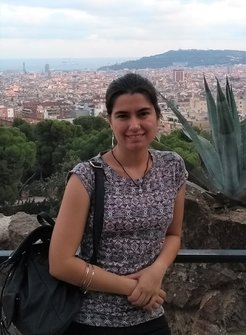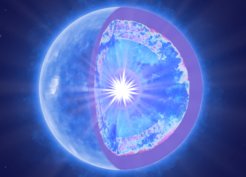Physics vs. Piano
Instead of following a musical career, MPA postdoc Tiara Battich is investigating the processes inside hot sub-dwarf stars

Why do some stars have very high abundances of heavy metals? How do elements form inside stars, and in particular a subclass of stars, which are basically made up only of a core? These questions Tiara Battich tries to answer at MPA with her stellar evolution models of hot sub-dwarf stars. Such stars have a low mass, only about half the mass of our Sun, and are fairly hot, with temperatures reaching a few 10 000 K. And they show a wide variety of types: Some have a thin layer of hydrogen, sometimes intermixed with Helium, some no hydrogen at all. Some pulsate, some don’t. In some, the fraction of very heavy elements such as lead, yttrium or zirconium can reach 10 000 times the solar level or more. However, as they cannot form by the canonical ways along the main sequence, the formation of these hot-subdwarfs is not very well understood – one reason, why Tiara got interested in them.
Hot sub-dwarfs often form in binary systems from a gas cloud, but also the merger of two stars might produce such a star. However, the really interesting part starts after the star has burned all its hydrogen at the core: When the temperature gets high enough to fuse helium, nucleosynthesis sets in again very suddenly and produces a so-called “helium flash”; sometimes followed by another hydrogen flash. Tiara is exploring the nucleosynthesis inside the hot sub-dwarfs and found that the formation of the very heavy elements depends on the details of the stellar models. Her findings may also help to understand the formation of heavy elements in low-mass stars in general and at the beginning of our galaxy.

Tiara came to MPA because she liked what she saw during a one-week-visit in 2018: many people doing theory and lots of knowledge in modelling, both the physical and computational aspects. So, when she got offered a postdoc position in 2020, she immediately accepted and stopped looking for other options after she finished her studies at the university in La Plata, Argentina, where she did both her “licenciatura” and her PhD.
However, it was not always clear that she would pursue a scientific career. Even though she was already interested in stars when she was 9 years old, her second passion was music. She started playing instruments at a young age and went to a music-oriented high-school, where she learned to play the piano. But instead of going to the Conservatory and following a musical career, she decided to try out physics – a subject she never studied at school. After the first year at university, Tiara’s path was clear: She wants to spend her life learning more about the universe. While her start at MPA was not easy – with the pandemic, she could not meet many people – she got settled in Munich now and is planning to buy a digital piano. This will complement her outdoor activities, where she explores Munich, the Alps, and especially the many lakes with her brother and friends.













